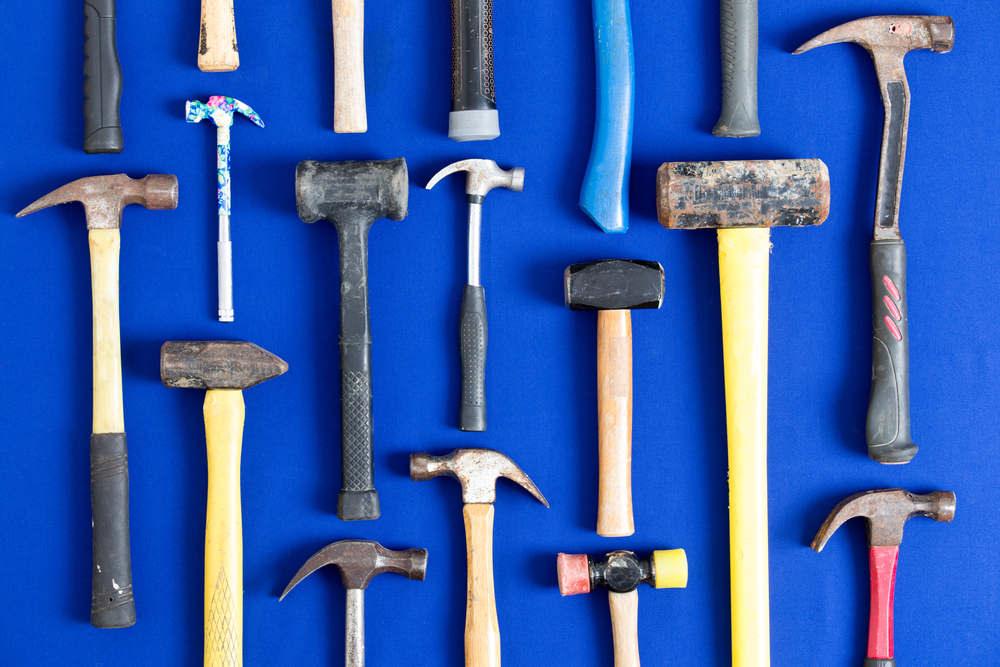Hammers are a basic tool that can be found in nearly every household and workshop. They are used for a variety of tasks, including driving and removing nails, shaping and forming metal, and breaking and shaping brick and concrete. There are many different types of hammers, each designed for specific purposes. In this article, we will discuss 10 different types of hammers and their uses.
Contents
Claw Hammer
The claw hammer is perhaps the most common type of hammer. It is typically used for driving and removing nails. It has a flat head on one end for driving nails and a claw on the other end for removing nails. The claw can also be used to pry objects apart or as a makeshift screwdriver. Claw hammers come in a variety of sizes and handle lengths to suit different needs.
One variation of the claw hammer is the curved claw hammer, which has a curved claw for easier nail removal in tight spaces. Another variation is the straight claw hammer, which has a straight claw for more leverage when removing nails.
Ball Peen Hammer
The ball peen hammer is a type of hammer with a round, peen-shaped head on one end and a flat head on the other. It is primarily used for shaping and forming metal, such as when working with steel or brass. The round head is used to create dimples or dents in the metal, while the flat head is used for general hammering tasks. Ball peen hammers come in a variety of sizes, with medium and large peen sizes being the most common.
Dead Blow Hammer
A dead blow hammer is a type of hammer that is designed to deliver a non-rebounding blow. It is typically used when precision or minimal damage is important, such as when working with delicate machinery or when removing dents from a car. Dead blow hammers are made with a hollow head filled with a weight, such as lead or steel shot, that helps to absorb the impact of the blow. Some dead blow hammers are also made with a plastic head filled with sand or other materials.
Brick Hammer
A brick hammer is a type of hammer specifically designed for breaking and shaping brick and concrete. It has a flat head on one end and a chisel-like point on the other end. The flat head is used for general hammering tasks, while the pointed end is used for carving and shaping brick and concrete. A good brick hammer should have a sturdy handle and a weight that is comfortable to use for extended periods.
Sledgehammer
A sledgehammer is a type of hammer with a large, heavy head and a long handle. It is used for delivering heavy blows to objects, such as when breaking up concrete or driving stakes into the ground. Sledgehammers come in a variety of sizes, with short handle and long handle options available.
Bricklayer’s Hammer
A bricklayer’s hammer is a type of hammer specifically designed for laying bricks. It has a pick on one end and a chisel on the other end. The pick is used for breaking and shaping bricks, while the chisel is used for making precise cuts. A good bricklayer’s hammer should have a sturdy handle and a weight that is comfortable to use for extended periods.
Dead Blow Sledgehammer
A dead blow sledgehammer is a type of sledgehammer that is designed to deliver a heavy, non-rebounding blow. It is typically used when precision or minimal damage is important, such as when working with delicate machinery or when removing dents from a car. Like the dead blow hammer, a dead blow sledge
A brass hammer is a type of hammer with a head made of brass, a type of metal alloy that is composed of copper and zinc. Brass is known for its strength, durability, and corrosion resistance, making it a suitable material for use in hammers. Brass hammers are typically used for delicate tasks where precision is important, such as when working with jewelry or electronics.
They are also often used in automotive and aircraft repair, as the softer brass head is less likely to damage delicate parts. Brass hammers are available in a variety of sizes and styles, including ball peen hammers, dead blow hammers, and claw hammers.
Bushing Hammer
A bushing hammer is a type of hammer with a small, cylindrical head that is used for driving bushings, which are metal or plastic sleeves that are used to protect and support bearings or other mechanical parts. Bushing hammers are typically used in automotive and aerospace industries, as well as in the construction and manufacturing sectors. They are designed to deliver precise, controlled blows to bushings without damaging the surrounding material. Bushing hammers may have either a solid or hollow head, and they are usually made with a lightweight, durable material such as aluminum or fiberglass. Some bushing hammers also have a built-in punch for removing bushings from their housing.
Cross Peen Hammer
A cross peen hammer is a type of hammer with a head that has a cross-shaped peen on one end and a flat head on the other end. The cross peen is used for shaping and forming metal, while the flat head is used for general hammering tasks. Cross peen hammers are often used in blacksmithing and other metalworking crafts, as the cross-shaped peen allows for greater control and precision when shaping hot metal.
They are also sometimes used in automotive and aerospace repair, as well as in construction and manufacturing industries. Cross peen hammers are available in a variety of sizes and styles, and they are typically made with a strong, durable material such as steel or brass.
In addition to these common types of hammers, there are also specialized hammers for tasks such as framing, drywall installation, and carpentry. It is important to select the right hammer for the job, as using the wrong hammer can result in poor performance and potentially even damage to the material being worked on.
FAQ’s on Different Types of Hammers
What are the different types of hammers?
Some common types of hammers include claw hammers, ball peen hammers, dead blow hammers, brick hammers, sledgehammers, bricklayer’s hammers, stonemason’s hammers, framing hammers, drywall hammers, and carpentry hammers.
What is a claw hammer used for?
A claw hammer is typically used for driving and removing nails. It has a flat head on one end for driving nails and a claw on the other end for removing nails.
What is a ball peen hammer used for?
A ball peen hammer is primarily used for shaping and forming metal, such as when working with steel or brass. The round head is used to create dimples or dents in the metal, while the flat head is used for general hammering tasks.
What is a dead blow hammer used for?
A dead blow hammer is a type of hammer that is designed to deliver a non-rebounding blow. It is typically used when precision or minimal damage is important, such as when working with delicate machinery or when removing dents from a car.
What is a brick hammer used for?
A brick hammer is a type of hammer specifically designed for breaking and shaping brick and concrete. It has a flat head on one end and a chisel-like point on the other end. The flat head is used for general hammering tasks, while the pointed end is used for carving and shaping brick and concrete.
What is a sledgehammer used for?
A sledgehammer is a type of hammer with a large, heavy head and a long handle. It is used for delivering heavy blows to objects, such as when breaking up concrete or driving stakes into the ground.
What is a bricklayer’s hammer used for?
A bricklayer’s hammer is a type of hammer specifically designed for laying bricks. It has a pick on one end and a chisel on the other end. The pick is used for breaking and shaping bricks, while the chisel is used for making precise cuts.
What is a stonemason’s hammer used for?
A stonemason’s hammer is a type of hammer specifically designed for shaping and dressing stone. It has a pointed end for carving and a flat end for general hammering tasks.
How do I choose the right hammer for my needs?
When choosing a hammer, consider the type of work you will be doing, the materials you will be working with, and your personal preferences. For example, if you will be working with metal, a ball peen hammer may be the best choice. If you will be working with brick and concrete, a brick hammer or sledgehammer may be more suitable. Consider the weight and handle material of the hammer, as well as any additional features it may have, such as a built-in punch or non-rebounding head.
Final Take
There are many different types of hammers, each designed for specific tasks. Some of the most common types of hammers include claw hammers, ball peen hammers, dead blow hammers, brick hammers, and sledgehammers. Other specialized hammers include bricklayer’s hammers, stonemason’s hammers, framing hammers, drywall hammers, and carpentry hammers.
It is important to select the right hammer for the job, as using the wrong hammer can result in poor performance and potentially even damage to the material being worked on. Proper maintenance and storage of hammers can also help to ensure their longevity and effectiveness. Overall, hammers are an essential tool for any DIY project or professional job, and understanding the different types and their uses can help you to choose the best hammer for your needs.

